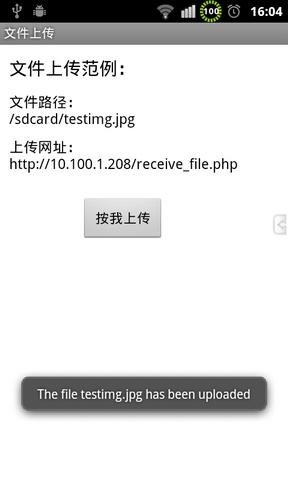Android上传文件到服务器,通常采用构造http协议的方法,模拟网页POST方法传输文件,服务器端可以采用JavaServlet或者PHP来接收要传输的文件。使用JavaServlet来接收文件的方法比较常见,在这里给大家介绍一个简单的服务器端使用PHP语言来接收文件的例子。
服务器端代码比较简单,接收传输过来的文件:
- <?php
- $target_path = "./upload/";//接收文件目录
- $target_path = $target_path . basename( $_FILES['uploadedfile']['name']);
- if(move_uploaded_file($_FILES['uploadedfile']['tmp_name'], $target_path)) {
- echo "The file ". basename( $_FILES['uploadedfile']['name']). " has been uploaded";
- } else{
- echo "There was an error uploading the file, please try again!" . $_FILES['uploadedfile']['error'];
- }
- ?>
手机客户端代码:
- package com.figo.uploadfile;
- import java.io.BufferedReader;
- import java.io.DataOutputStream;
- import java.io.FileInputStream;
- import java.io.InputStream;
- import java.io.InputStreamReader;
- import java.net.HttpURLConnection;
- import java.net.URL;
- import android.app.Activity;
- import android.os.Bundle;
- import android.view.View;
- import android.widget.Button;
- import android.widget.TextView;
- import android.widget.Toast;
- public class UploadfileActivity extends Activity
- {
- // 要上传的文件路径,理论上可以传输任何文件,实际使用时根据需要处理
- private String uploadFile = "/sdcard/testimg.jpg";
- private String srcPath = "/sdcard/testimg.jpg";
- // 服务器上接收文件的处理页面,这里根据需要换成自己的
- private String actionUrl = "http://10.100.1.208/receive_file.php";
- private TextView mText1;
- private TextView mText2;
- private Button mButton;
- @Override
- public void onCreate(Bundle savedInstanceState)
- {
- super.onCreate(savedInstanceState);
- setContentView(R.layout.main);
- mText1 = (TextView) findViewById(R.id.myText2);
- mText1.setText("文件路径:\n" + uploadFile);
- mText2 = (TextView) findViewById(R.id.myText3);
- mText2.setText("上传网址:\n" + actionUrl);
- /* 设置mButton的onClick事件处理 */
- mButton = (Button) findViewById(R.id.myButton);
- mButton.setOnClickListener(new View.OnClickListener()
- {
- @Override
- public void onClick(View v)
- {
- uploadFile(actionUrl);
- }
- });
- }
- /* 上传文件至Server,uploadUrl:接收文件的处理页面 */
- private void uploadFile(String uploadUrl)
- {
- String end = "\r\n";
- String twoHyphens = "--";
- String boundary = "******";
- try
- {
- URL url = new URL(uploadUrl);
- HttpURLConnection httpURLConnection = (HttpURLConnection) url
- .openConnection();
- // 设置每次传输的流大小,可以有效防止手机因为内存不足崩溃
- // 此方法用于在预先不知道内容长度时启用没有进行内部缓冲的 HTTP 请求正文的流。
- httpURLConnection.setChunkedStreamingMode(128 * 1024);// 128K
- // 允许输入输出流
- httpURLConnection.setDoInput(true);
- httpURLConnection.setDoOutput(true);
- httpURLConnection.setUseCaches(false);
- // 使用POST方法
- httpURLConnection.setRequestMethod("POST");
- httpURLConnection.setRequestProperty("Connection", "Keep-Alive");
- httpURLConnection.setRequestProperty("Charset", "UTF-8");
- httpURLConnection.setRequestProperty("Content-Type",
- "multipart/form-data;boundary=" + boundary);
- DataOutputStream dos = new DataOutputStream(
- httpURLConnection.getOutputStream());
- dos.writeBytes(twoHyphens + boundary + end);
- dos.writeBytes("Content-Disposition: form-data; name=\"uploadedfile\"; filename=\""
- + srcPath.substring(srcPath.lastIndexOf("/") + 1)
- + "\""
- + end);
- dos.writeBytes(end);
- FileInputStream fis = new FileInputStream(srcPath);
- byte[] buffer = new byte[8192]; // 8k
- int count = 0;
- // 读取文件
- while ((count = fis.read(buffer)) != -1)
- {
- dos.write(buffer, 0, count);
- }
- fis.close();
- dos.writeBytes(end);
- dos.writeBytes(twoHyphens + boundary + twoHyphens + end);
- dos.flush();
- InputStream is = httpURLConnection.getInputStream();
- InputStreamReader isr = new InputStreamReader(is, "utf-8");
- BufferedReader br = new BufferedReader(isr);
- String result = br.readLine();
- Toast.makeText(this, result, Toast.LENGTH_LONG).show();
- dos.close();
- is.close();
- } catch (Exception e)
- {
- e.printStackTrace();
- setTitle(e.getMessage());
- }
- }
- }
在AndroidManifest.xml文件里添加网络访问权限:
- <uses-permission android:name="android.permission.INTERNET" />
运行结果:

来源:oschina
链接:https://my.oschina.net/u/262886/blog/63651